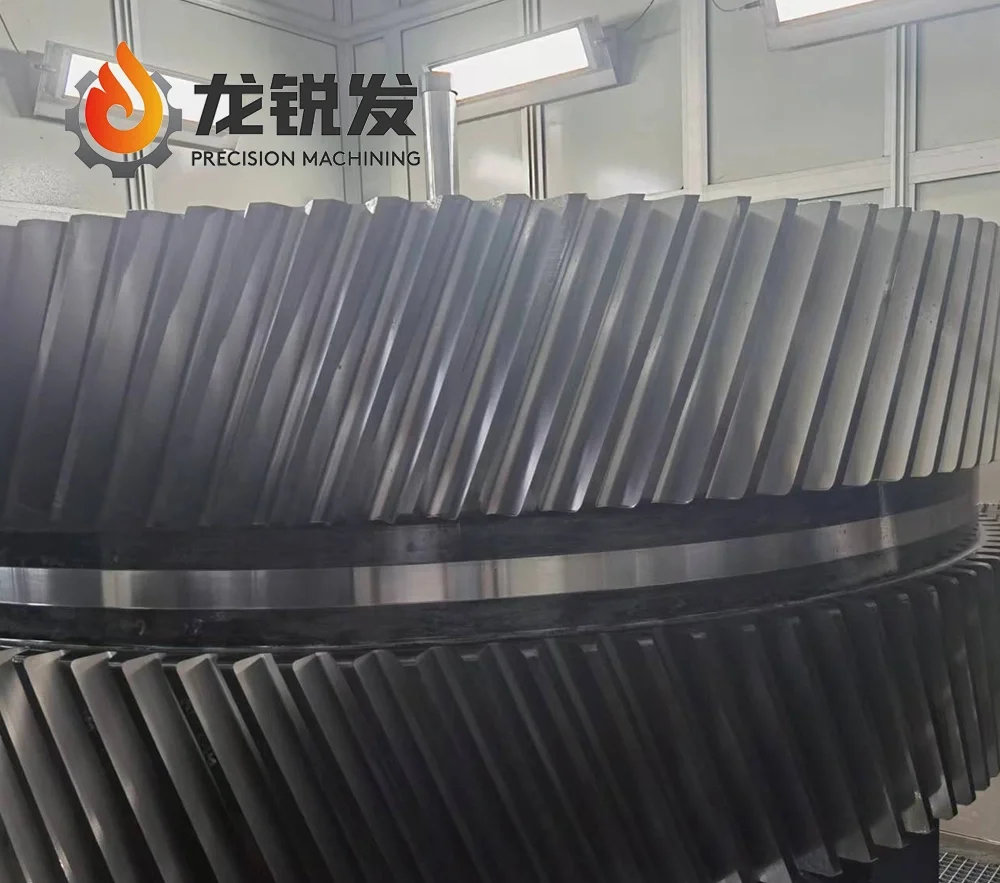- This topic is empty.
-
AuthorPosts
-
2025-07-17 at 5:10 pm #4195
Herringbone gears are a vital component in heavy-duty industrial machinery, known for their ability to transmit high torque with smooth, quiet operation. Their unique V-shaped double helical design eliminates axial thrust, making them ideal for applications such as marine propulsion systems, power plants, and heavy-duty gearboxes. In this blog post, Longruifa will share the high precision industrial herringbone gear manufacturing process, including aspects such as precision and material quality.
1. Understanding Herringbone Gear Design
Herringbone gears consist of two helical gears of opposite hands mounted side by side. Unlike standard helical gears, the mirrored arrangement of teeth cancels out the axial forces, making them more stable during high-load operation. This design, however, also introduces complexity in manufacturing, requiring exact alignment and specialized equipment to achieve perfect symmetry.
Key Benefits of Herringbone Gears:
* High load-carrying capacity
* Smooth and quiet transmission
* Zero axial thrust
* Increased operational reliability
2. Material Selection for Durability and Performance
The foundation of a precision gear lies in the quality of the raw material. Materials are chosen based on required mechanical properties, wear resistance, and thermal stability.
Commonly Used Materials:
* Alloy Steel (e.g., 42CrMo4, 18CrNiMo7-6) – Offers excellent hardness and strength after heat treatment.
* Cast Steel and Cast Iron – Suitable for large-diameter gears with good machinability.
* Carburizing Steel – Ideal for surface hardening while maintaining a tough core.
Material preparation includes ultrasonic testing and metallurgical analysis to ensure homogeneity, minimize inclusions, and eliminate internal defects.
3. Precision Forging or Casting
Depending on size and performance requirements, herringbone gears may be forged or cast.
* Forging Process: Preferred for smaller gears requiring high tensile strength. It enhances the grain structure, improving fatigue resistance.
* Casting Process: Suitable for large or complex gear shapes. Modern investment or sand casting techniques ensure dimensional accuracy and surface quality.
Post-forming heat treatment, such as normalizing or annealing, is applied to relieve internal stresses before further machining.

4. Rough Machining and Pre-Processing
Once the gear blank is prepared, it undergoes rough machining operations:
* Turning: To achieve the correct diameter and face width.
* Drilling/Boring: For shaft bore or keyways.
* Facing: To prepare reference surfaces for precise alignment in later stages.
At this stage, tolerances are kept loose, allowing sufficient material for finish machining.
5. Gear Cutting and Tooth Forming
This is the core step in herringbone gear manufacturing and requires extreme accuracy. There are two primary methods:
a. Gear Hobbing (with Interrupted Hobbing Method)
Traditionally, hobbing machines cut one helix at a time, leaving a small clearance gap at the centerline. This method is more economical but introduces a discontinuity that can impact strength and smoothness.
b. Continuous Gear Shaping (Preferred for High Precision)
A special double helical cutter moves in synchronization with the blank to cut both helices simultaneously. This process ensures:
* No center groove
* Perfect tooth alignment
* Superior transmission smoothness
Modern CNC shaping machines equipped with digital controllers allow real-time monitoring and adjustments for enhanced precision.
6. Heat Treatment for Enhanced Hardness
To ensure long service life and wear resistance, heat treatment is applied based on the steel grade:
* Carburizing & Quenching: For surface hardening while maintaining ductile cores.
* Induction Hardening: Targeted hardening of tooth flanks.
* Tempering: To reduce brittleness and enhance toughness.
Post-treatment, gears undergo distortion control and stress relief to ensure dimensional stability.
7. Finish Machining and Grinding
After hardening, the gear undergoes precision grinding to achieve final dimensions and surface finish:
* Tooth Grinding: Using specialized CNC grinders to achieve tight tolerances and high surface finish (Ra < 0.4 µm).
* Bore and Face Grinding: For perfect concentricity and perpendicularity.
This step ensures gear tooth profile accuracy, surface contact consistency, and optimal noise reduction during operation.
8. Quality Control and Inspection
Comprehensive inspection is crucial to validate performance and compliance with design specifications. Common inspection techniques include:
* Coordinate Measuring Machine (CMM): For 3D measurement of tooth geometry and alignment.
* Profile Projector or Gear Tester: To check lead, profile, and pitch errors.
* Magnetic Particle or Ultrasonic Testing: To detect surface and subsurface cracks.
All gears are evaluated against ISO 1328 or AGMA standards, depending on industry requirements.
9. Assembly and Final Balancing
If the herringbone gear is part of an assembled gearbox or drive system, it undergoes:
* Dynamic Balancing: To minimize vibration and ensure quiet operation at high RPMs.
* Assembly with Bearings and Housings: With tight tolerances and proper lubrication channels.
* Run-In Testing: Simulates actual working conditions to check noise levels, backlash, and thermal behavior.
10. Conclusion
The manufacturing of high precision herringbone gears is a blend of materials science, advanced machining, and rigorous quality assurance. These gears are more than just mechanical parts—they are precision-engineered components that ensure uninterrupted operation in the most demanding industrial settings.
Investing in top-tier manufacturing processes not only extends equipment life but also guarantees operational efficiency, safety, and long-term reliability. As industries move toward smarter and more durable machinery, the role of precision herringbone gears remains irreplaceable.
http://www.lrfgears.com
Longruifa -
AuthorPosts
- You must be logged in to reply to this topic.

